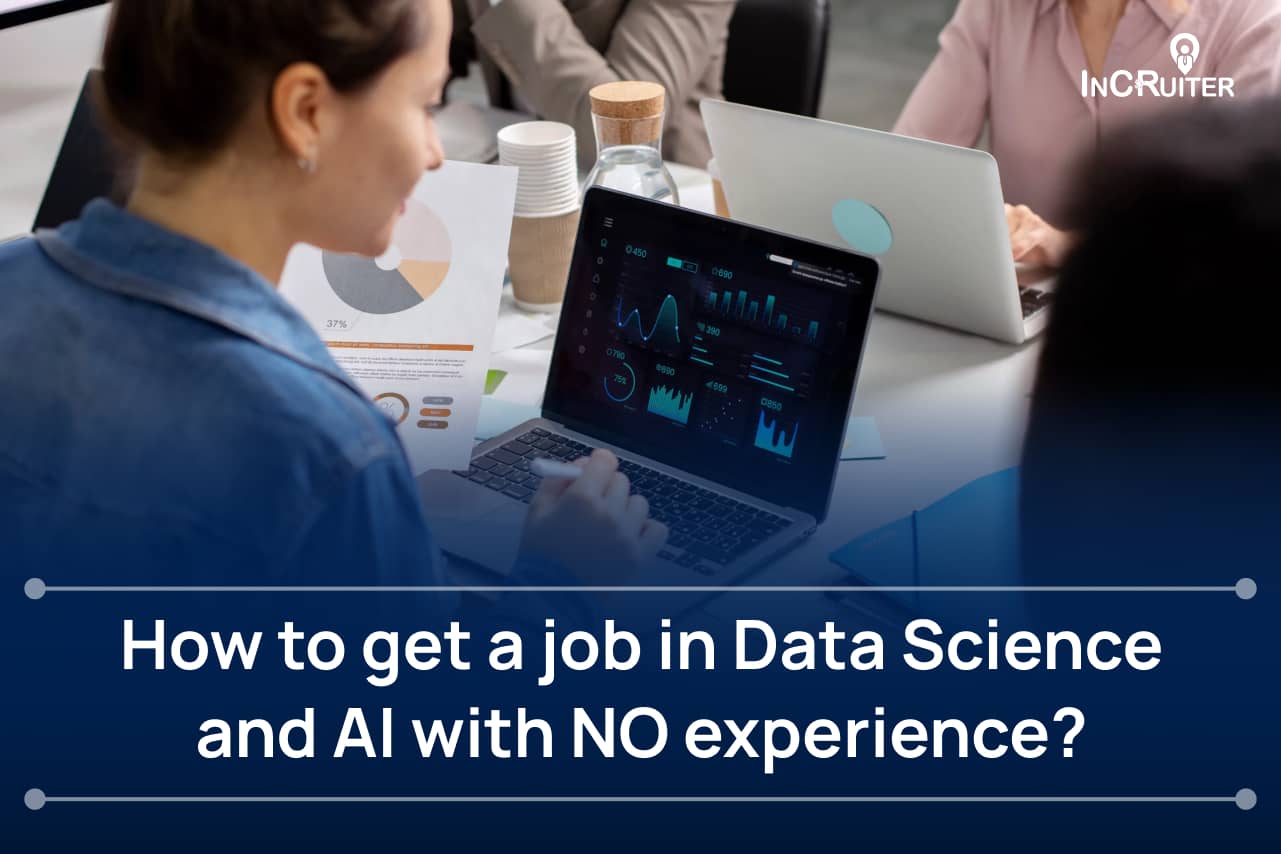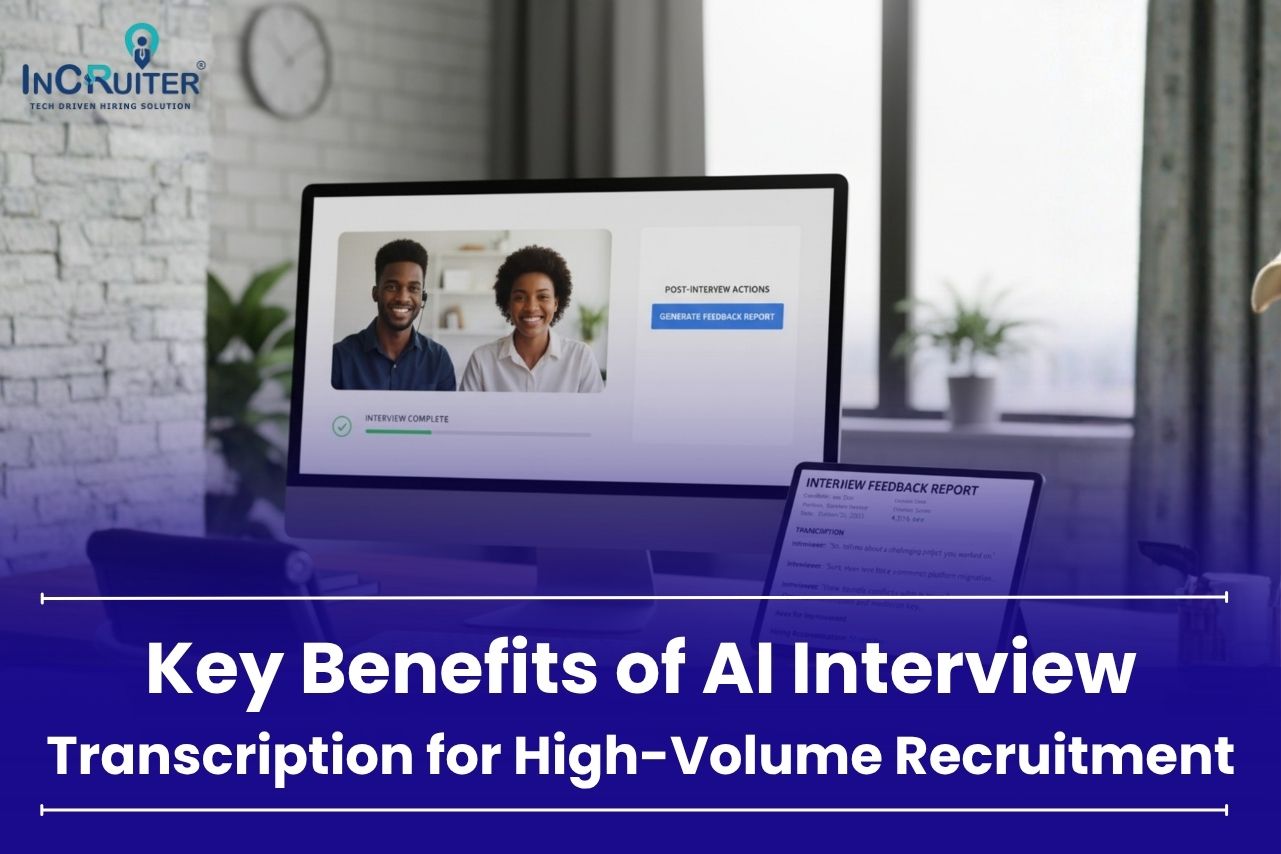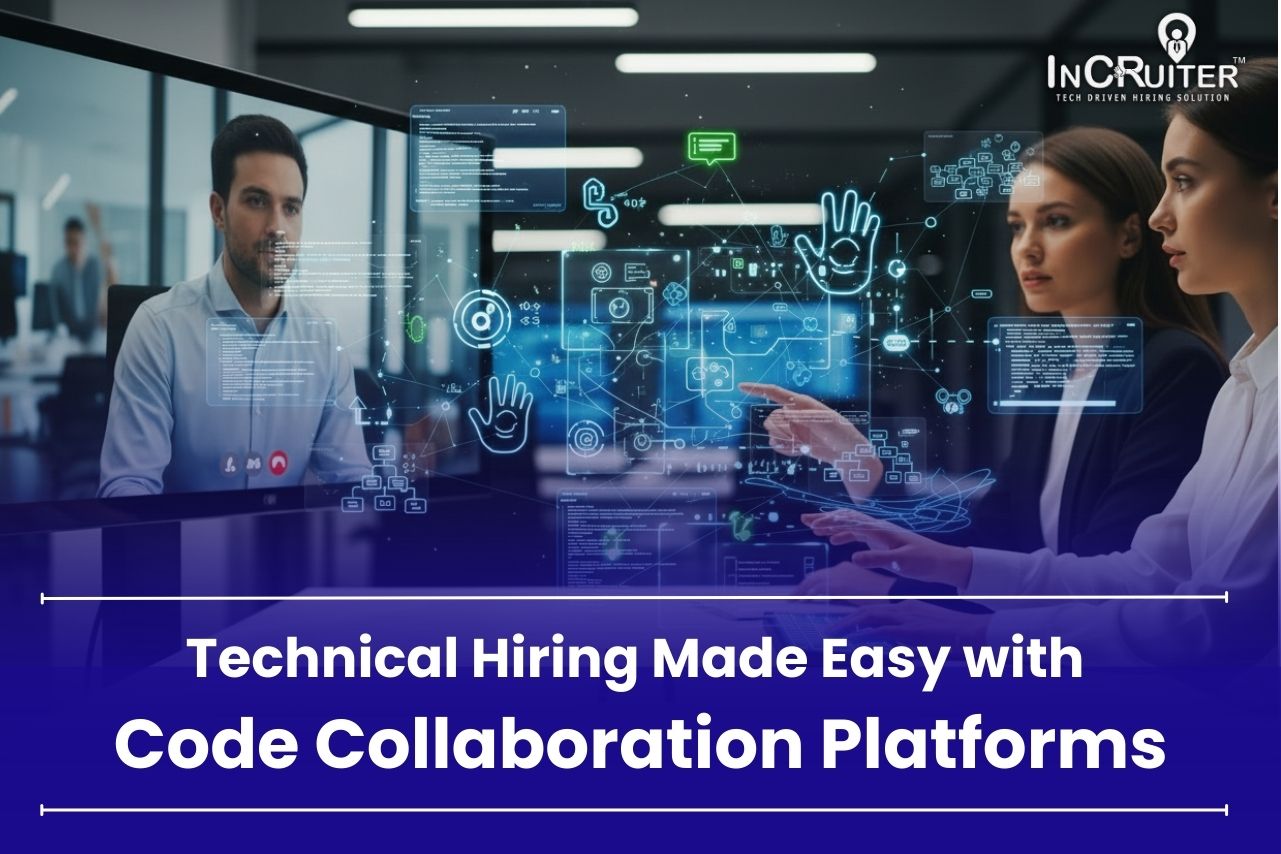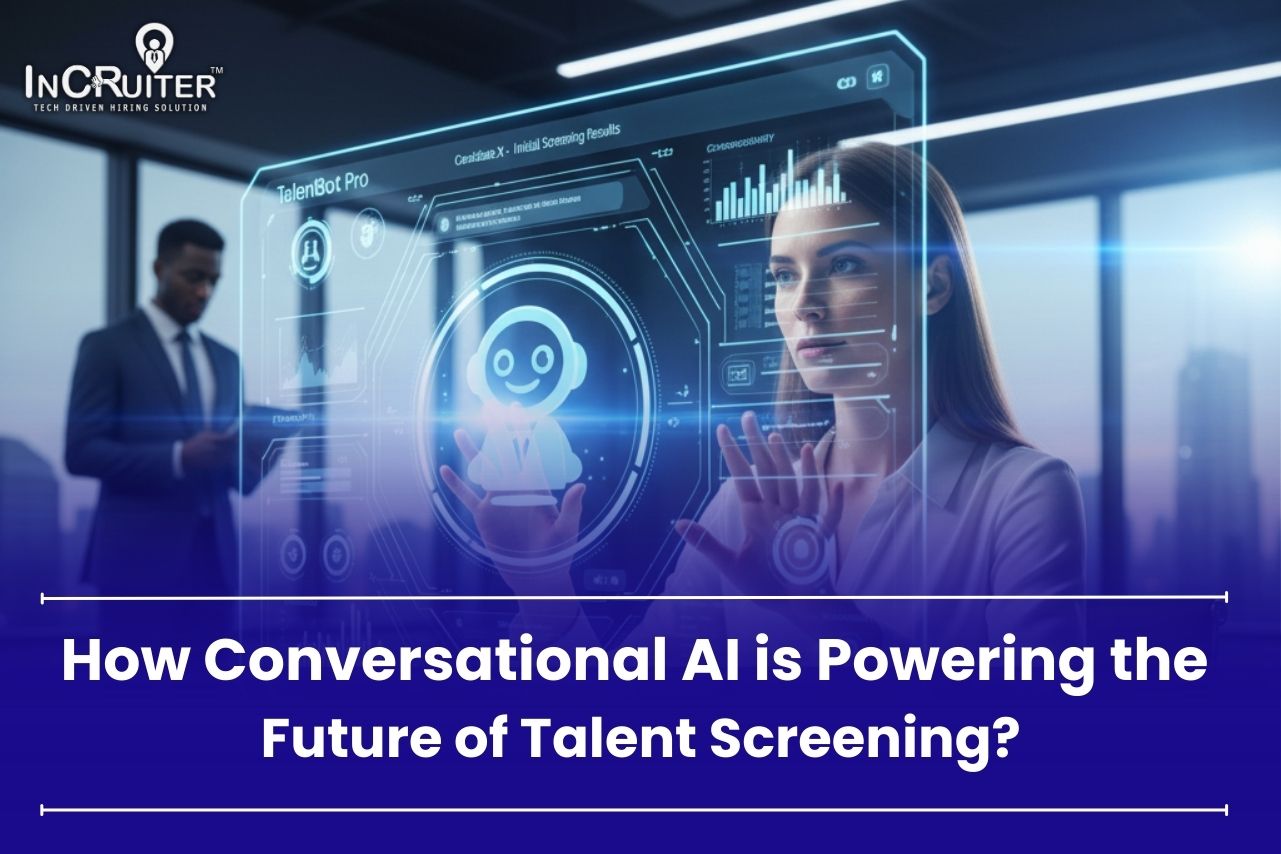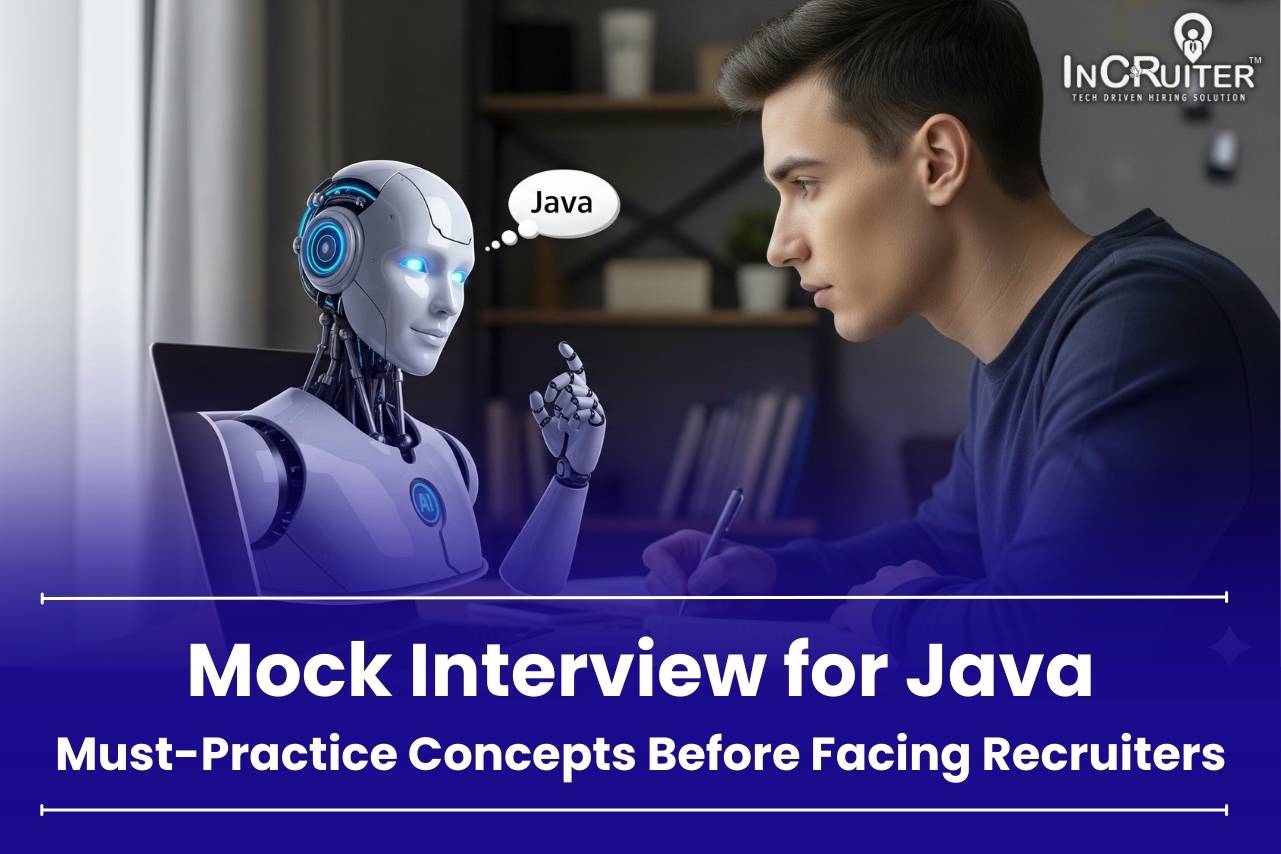Breaking into data science and AI without any prior experience? Sounds like signing up for a marathon without sneakers, right? But here’s the fun part. It’s absolutely doable. You don’t need to have been coding since you were 12 or hold a Ph.D. in rocket science to enter this field. In fact, many professionals today have pivoted into data science from completely unrelated backgrounds, think marketing, teaching, or even fine arts. Yes, really!
This blog isn’t about lofty advice like “Learn Python, and the world will be yours.” Nope. It’s about giving you an actionable roadmap of how you can start from scratch, build skills, create a killer portfolio, and get noticed by hiring managers. If you’ve got curiosity, grit, and a Wi-Fi connection, you’re already halfway there. Let’s talk real steps to land that dream job in data science and AI, no matter where you’re starting from!
Guide to Getting Started with Data Science and AI
Data Science
Data science isn’t just about crunching numbers. It’s about telling stories with data, building models that predict cool stuff (like what movie you’ll binge next), and solving problems with logic and creativity. So, where do you even begin? By getting your hands dirty with the right tools, concepts, and buzzwords. Here’s your cheat sheet to become a data-savvy rockstar:
Potential Roles
- Data Analyst: Crunches numbers and turns them into meaningful insights.
- Data Scientist: A mix of analyst, statistician, and coder – aka the unicorn.
- AI Engineer: Designs systems that mimic human intelligence (yes, like chatbots).
- Data Engineer: Manages the pipelines where all the juicy data flows.
- Decision Scientist: Tells businesses what to do with their data-driven decisions.
Things to Learn
- Python: The most versatile and widely-used language in data science.
- SQL: For querying and managing data in databases.
- Statistics: The foundation for analyzing and interpreting data.
- Data Visualization: Master tools to present insights effectively (e.g., Tableau, Matplotlib).
- Big Data Tools: Understand Hadoop or Spark for large-scale data handling.
Artificial Intelligence (AI)
AI is revolutionizing industries, from healthcare to finance, by driving innovations and solving complex problems. The emergence of no-code tools has further democratized AI, enabling individuals to design and prototype solutions without requiring advanced programming expertise. By mastering AI concepts and tools, you can unlock future-ready career opportunities in fields such as machine learning, data analysis, and AI-driven product development. With the right skills and determination, this transformative domain offers immense potential for impactful and rewarding careers.
Potential Roles
- AI Researcher: Focuses on discovering new algorithms and advancing AI technologies.
- AI Engineer: Builds and deploys AI solutions into practical systems.
- Natural Language Processing Specialist: Works on systems like chatbots and translation tools.
- Computer Vision Engineer: Designs models for tasks like facial recognition and image processing.
- Robotics Engineer: Develops AI-powered machines capable of interacting with the physical world.
- AI Product Manager: Oversees AI-driven projects, ensuring alignment with business objectives.
- Prompt Engineer: Designs and optimizes prompts to guide AI models for specific, accurate, and efficient outputs across various applications.
Things to Learn
- Machine Learning: The foundation of AI, enabling systems to learn from data and make intelligent predictions.
- Deep Learning: A specialized branch of machine learning focused on solving complex problems using neural networks.
- Natural Language Processing (NLP): Teaching machines to understand, process, and generate human language for advanced communication.
- Computer Vision: Empowering AI to interpret and analyze visual data, from images to videos.
- Generative AI: Creating new, realistic data like text, images, or audio using cutting-edge models like GANs and transformers.
- AI Model Deployment and Optimization: Bringing AI solutions to life by ensuring they are scalable, efficient, and impactful in production.
- AI Ethics: Ensuring responsible AI development by addressing bias, fairness, and privacy concerns.
Prerequisites to Build Your Foundation
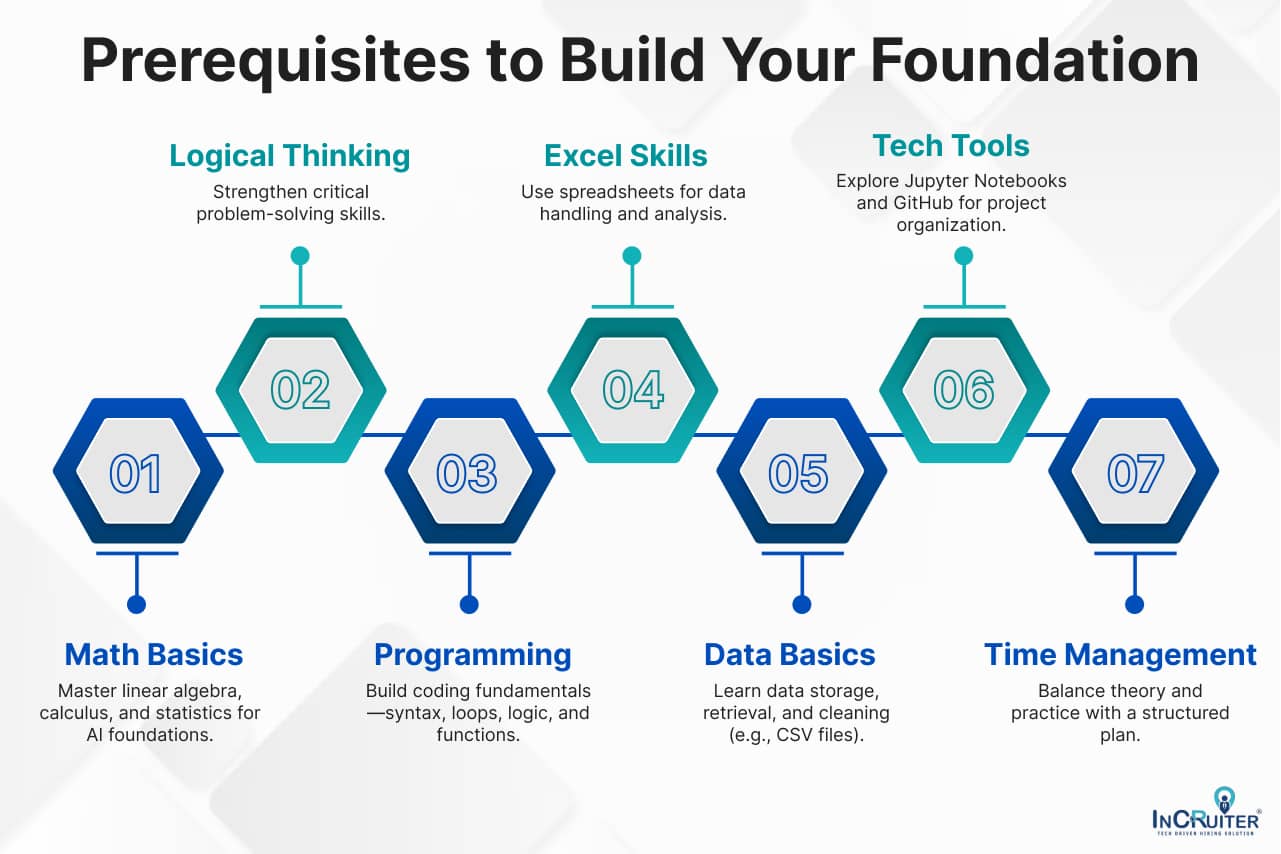
Before diving headfirst into data science and AI, it’s essential to build a solid base. Think of these prerequisites as the warm-up exercises before you hit the main workout. They might not seem glamorous, but mastering these basics will save you countless headaches down the road and give you a clear path forward.
- Basic Math Skills: Get comfortable with linear algebra, calculus, and statistics; they’re the backbone of every data model and AI algorithm.
- Logical Thinking: Sharpen your ability to break down problems logically and think critically about solutions.
- Programming Fundamentals: Start with the basics and understand syntax, loops, logic, and functions to build a strong coding foundation.
- Excel & Spreadsheets: Learn how to work with data using tools such as Excel or Google Sheets, which remain essential for handling and analyzing data effectively.
- Data Handling Basics: Understand how data is stored, retrieved, and cleaned using simple file manipulations (like CSV).
- Tech Curiosity: Familiarize yourself with tech tools like Jupyter Notebooks and GitHub to organize your projects.
- Time Management: Develop a structured learning plan; balancing your time between theory and hands-on practice is key.
Best Resources to Learn Data Science
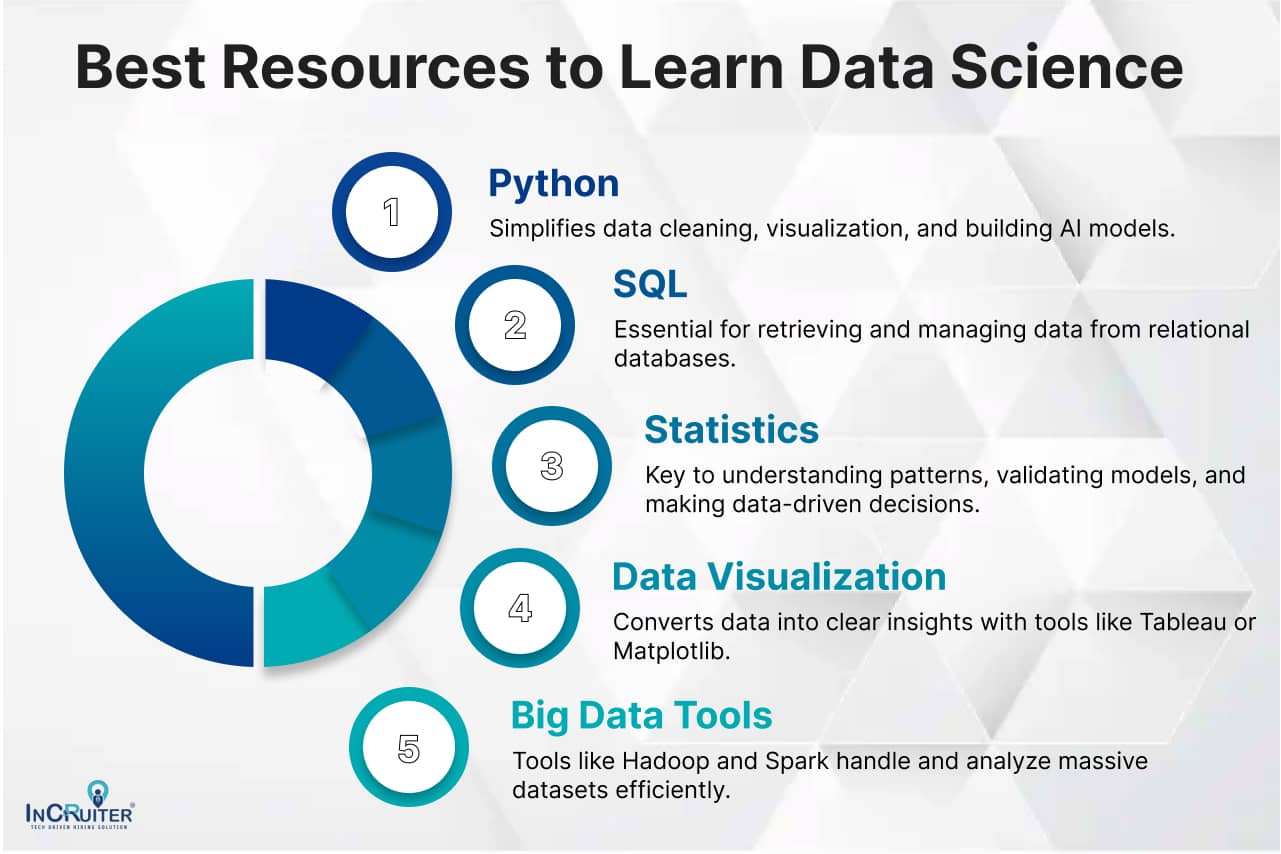
To carve out a successful career in data science, you need to build a diverse skill set that combines technical expertise, analytical thinking, and practical problem-solving. Here’s what you need to have in your toolkit:
1. Python
Python is the go-to language for data science, loved for its simplicity and versatility. It allows you to clean data, create visualizations, and build machine learning models effortlessly. From data manipulation to deploying AI models, Python is at the core of every data scientist’s toolkit.
Top Resources for Python
- Python for Everybody Specialization by Coursera is a free course that covers all the basics and builds a solid programming foundation.
- 100 Days of Code: The Complete Python Pro Bootcamp by Udemy takes you through a project-based journey to master Python step by step.
- Python for Beginners by INeuron is a straightforward course designed for absolute beginners, offering hands-on exercises and clear explanations.
Readings
- Python Documentation: docs.python.org
- “Learn Python the Hard Way” by Zed A. Shaw
2. SQL
SQL is essential for accessing and managing data stored in relational databases. It’s the backbone of data retrieval, helping you pull insights from structured datasets and make them usable for analysis or modeling.
Top Resources for SQL
- Learn SQL Basics for Data Science Specialization by Coursera, a beginner-friendly course to understand the essentials of SQL in data science.
- The Complete SQL Bootcamp: Go from Zero to Hero by Udemy, a comprehensive guide to mastering SQL queries and database management.
- SQL Certification Course by Simplilearn, designed for those aiming to gain advanced SQL skills and certification.
Readings
- SQL QuickStart Guide by Walter Shields
- “SQL for Data Scientists” by Renee M. P. Teate
3. Statistics
Statistics helps you understand data, detect patterns, and draw insights. It is the foundation of machine learning, enabling you to validate models and make informed decisions with confidence.
Top Resources for Statistics
- Probability & Statistics for Machine Learning and Data Science on Coursera
- Statistics & Mathematics for Data Science and Data Analytics on Udemy
- Statistics for Data Science on MyGreatLearning
Readings
- An Introduction to Statistical Learning: with Applications in R (Springer Texts in Statistics)
- “The Art of Statistics” by David Spiegelhalter
4. Data Visualization
Data visualization transforms raw numbers into insightful charts and graphs, helping stakeholders understand findings at a glance. Tools like Tableau and Matplotlib make your data speak volumes.
Top Resources for Data Visualization
- Data Analysis and Visualization Foundations Specialization on Coursera offers a comprehensive guide to understanding and applying visualization techniques effectively.
- Data Storytelling and Data Visualization Mastery on Udemy focuses on crafting compelling narratives through data for impactful communication.
- EDA and Data Visualization Course in Data Science by Scaler equips you with essential skills for exploratory data analysis and visualization, tailored for aspiring data scientists.
Readings
- “Storytelling with Data” by Cole Nussbaumer Knaflic
- “The Visual Display of Quantitative Information” by Edward R. Tufte
5. Big Data Tools
Big data tools like Hadoop and Spark handle enormous datasets that go beyond traditional computing limits. These tools are crucial for processing, storing, and analyzing large-scale information efficiently.
Top Resources for Big Data Tools
- Explore the fundamentals of big data with Introduction to Big Data with Spark and Hadoop on Coursera.
- Master advanced big data skills with Conquer Big Data: The Ultimate Hadoop & Spark Masterclass on Udemy.
- Dive deep into big data technologies with the Big Data Hadoop Course by Intellipaat.
Readings
- “Hadoop: The Definitive Guide” by Tom White
- “Learning Spark” by Jules S. Damji et al.
Best Resources to Learn Artificial Intelligence (AI)
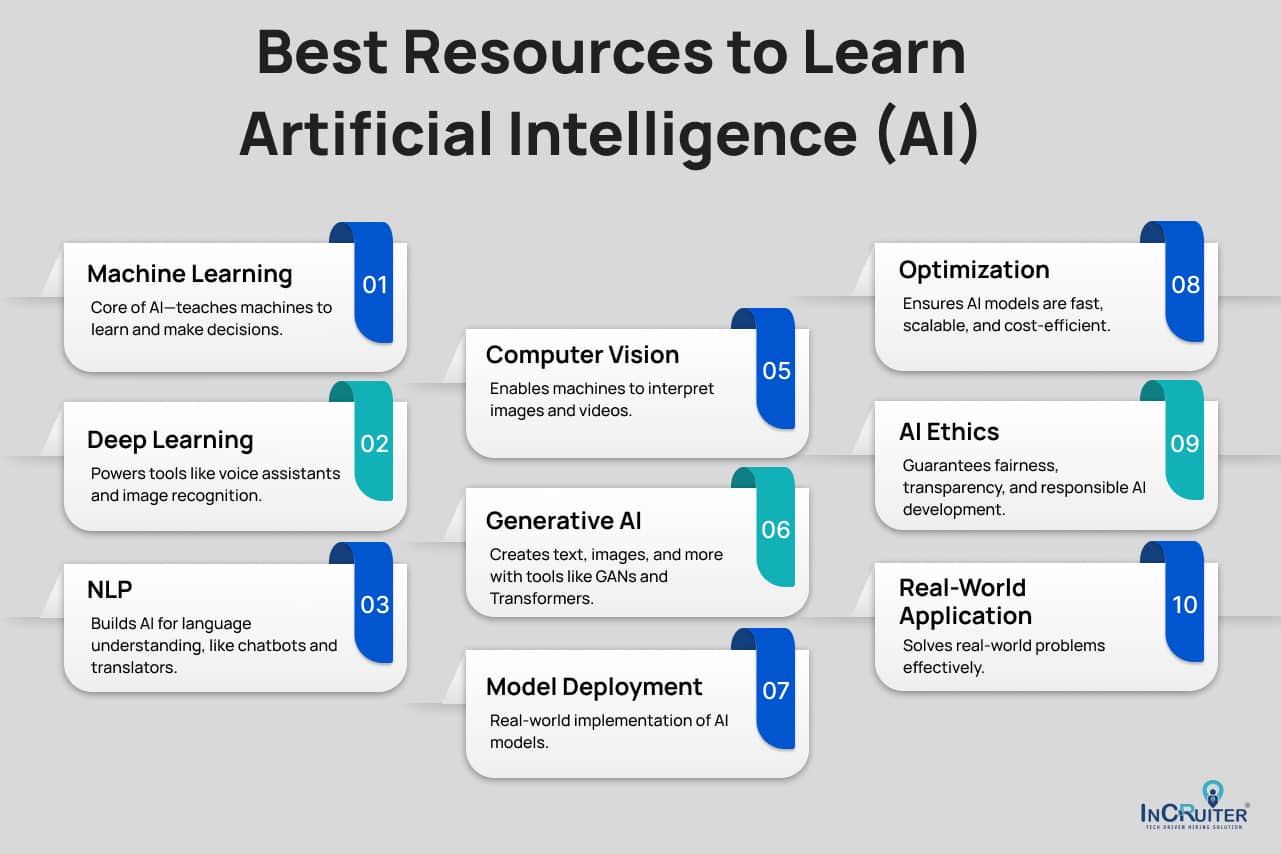
To thrive in the field of Artificial Intelligence, you need more than just a passion for innovation; you need a well-rounded skill set that combines technical know-how, creative problem-solving, and a deep understanding of how AI impacts the real world. Here’s what you should have in your AI toolkit:
1. Machine Learning
If you’re diving into AI, machine learning is your must-have first step. It’s all about teaching machines to identify patterns and make decisions from data through recommendation systems or predictive analytics. Without machine learning, AI is just a fancy buzzword. Building your career in AI starts here because it’s the foundation for everything else you’ll do, from analyzing data to creating smarter systems. By mastering techniques like AutoML, ensemble methods, and dimensionality reduction, you’ll be ready to tackle real-world challenges and work with complex datasets. Think of machine learning as your entry ticket to the AI world, so don’t skip it!
Top Resources for Machine Learning
- Machine Learning Specialization by Coursera is a complete course covering basic to advanced machine learning concepts.
- Complete A.I. & Machine Learning, Data Science Bootcamp by Udemy offers practical projects for hands-on learning.
- Complete Machine Learning & Data Science Program by GeeksforGeeks focuses on machine learning, data science, and interview preparation.
Readings
- “The Hundred-Page Machine Learning Book” by Andriy Burkov
- “Pattern Recognition and Machine Learning” by Christopher Bishop
2. Deep Learning
When you’ve nailed machine learning, it’s time to level up with deep learning. This specialization uses neural networks to solve insanely cool problems like teaching machines to recognize images, forecast trends, or even create art. If AI is the brain, deep learning is its powerhouse, and it’s what makes tools like voice assistants and facial recognition possible. For a career in AI, deep learning takes your skills to new heights by enabling you to work on cutting-edge technologies like GANs, Transformers, and advanced time-series models. It’s the go-to skill for tackling the most complex and futuristic AI challenges out there.
Top Resources for Deep Learning Frameworks
- Explore the Deep Learning Specialization by Coursera, designed by Andrew Ng to cover foundational and advanced concepts.
- Enroll in Deep Learning with PyTorch and TensorFlow 2 on Udemy, offering hands-on experience with two of the most popular frameworks.
Readings
- “Deep Learning” by Ian Goodfellow, Yoshua Bengio, and Aaron Courville
- “Grokking Deep Learning” by Andrew W. Trask
3. Natural Language Processing (NLP)
Imagine teaching machines to understand and respond like humans; that’s NLP in action! From chatbots to sentiment analysis, NLP lets you build systems that process and generate human language. Why is it vital for your AI career? Because it’s what powers most of the AI we interact with daily, such as Alexa, Google Translate, you name it. With tools like BERT and GPT leading the charge, mastering NLP positions you to work on advanced conversational AI, text summarization, and even language-based search engines. AI is only as smart as it sounds, and with NLP, you’ll ensure it speaks fluently in every language.
Top Resources for Advanced NLP
- Deep Learning with Advanced Natural Language Processing by Udemy offers an in-depth exploration of NLP concepts and sequential models.
- Natural Language Processing Specialization by Coursera provides a comprehensive overview of modern NLP techniques and applications.
- Natural Language Processing by Udacity delivers practical, project-based learning to master NLP skills effectively.
Readings
- “Speech and Language Processing” by Jurafsky and Martin.
- “Practical Natural Language Processing” by Sowmya Vajjala et al.
4. Computer Vision
If AI had eyes, they’d rely on computer vision. This branch of AI lets machines process images and videos, from recognizing objects to analyzing medical scans or powering self-driving cars. Why does this matter for your career? Because industries everywhere need computer vision experts, whether it’s tech companies building AR tools or healthcare providers improving diagnostics. By mastering techniques like object detection, image segmentation, and 3D vision, you’ll be able to work on projects that transform how machines see the world. In AI, seeing is believing, and computer vision is how you prove your skills.
Top Resources for Computer Vision
- Enroll in Computer Vision Masterclass on Udemy to gain hands-on expertise in advanced computer vision techniques.
- Explore Introduction to Computer Vision and Image Processing on Coursera for a comprehensive understanding of foundational concepts.
- Access Learn Computer Vision with Online Courses and Programs on edX to dive deeper into specialized computer vision topics.
Readings
- “Programming Computer Vision with Python” by Jan Erik Solem.
- “Deep Learning for Vision Systems” by Mohamed Elgendy.
6. Generative AI
Generative AI is where innovation gets creative literally. It’s the field behind tools like ChatGPT and DALL-E, enabling machines to generate text, images, and even music. For a career in AI, generative AI opens doors to some of the most futuristic roles, from designing virtual worlds to creating personalized content at scale. Learning about GANs, transformers, and VAEs will let you build systems that not only learn but also create. Whether you’re into content generation or solving real-world problems with synthetic data, generative AI is where you turn imagination into reality. It’s fun, impactful, and highly in demand.
Top Resources for Generative AI
- Learn the fundamentals of Generative AI with Generative AI for Beginners on Udemy, designed for those starting out.
- Dive deeper into concepts and applications with Explore Generative AI, a comprehensive course on Coursera.
- Master advanced techniques with Advanced Executive Program in Applied Generative AI by Simplilearn, tailored for professionals.
Readings
- “Generative Deep Learning” by David Foster.
- “Grokking GANs” by Roni Mittelman.
7. AI Model Deployment and Optimization
Building an AI model is only half the battle; deploying and optimizing it is where the magic happens. This is the step that brings your AI ideas into the real world, whether it’s an app, a cloud service, or a business process. For your career in AI, knowing how to deploy scalable and efficient models sets you apart from the crowd. You’ll need skills in tools like Docker and Kubernetes, plus an eye for optimizing models to run faster and cheaper. In short, this is how you ensure your AI solutions aren’t just smart but also practical and impactful.
Top Resources for AI Model Deployment
- Learn practical deployment techniques with Deploying AI & Machine Learning Models for Business Python on Udemy.
- Explore real-world model deployment strategies in the AI Model Deployment course by Microsoft.
- Master end-to-end deployment and serving with the AI Model Deployment and Serving Course by NanoSchool.
Readings
- “Building Machine Learning Powered Applications” by Emmanuel Ameisen.
- “Practical MLOps” by Noah Gift.
9. AI Ethics
AI without ethics is like a car without brakes, which is powerful but dangerous. As AI transforms industries, ethical considerations ensure fairness, transparency, and accountability in every system you build. For your career, understanding AI ethics isn’t just nice to have. It’s essential. Employers are actively looking for professionals who can navigate bias, privacy concerns, and regulatory requirements. By mastering AI ethics, you’ll position yourself as a trusted expert who creates responsible AI solutions. The future of AI isn’t just about what machines can do; it’s about ensuring they do what’s right. Be the person who builds AI that people can trust.
Top Resources for AI Ethics
- Explore the Ethics of Artificial Intelligence program on Coursera, designed to delve into ethical dilemmas in AI systems.
- Enroll in the Ethics of AI course by the University of Helsinki, offering foundational knowledge in responsible AI practices.
- Gain certification through the Certificate in Ethical Artificial Intelligence (AI) by CISI, focusing on professional ethical standards in AI.
Readings
- Dive into The Oxford Handbook of Ethics of AI by Oxford University Press, a comprehensive guide to the ethical challenges and implications of AI.
Also read: Java Common Interview Questions
Conclusion
Stepping into the AI field might feel overwhelming at first, but with a well-structured plan and a focus on core skills like machine learning, deep learning, NLP, and computer vision, success is absolutely within reach. The key is to stay consistent, practice often, and apply your knowledge to real-world scenarios. Remember, AI is not just about understanding algorithms; it’s about building systems that make a difference.
If you want to dive deeper into these topics or practice machine learning, Java, or C++ questions, check out InCruiter rich library of resources. Our blogs are designed to guide you toward your dream job, offering practical insights and learning materials. Plus, you can boost your confidence by trying InCruiter’s Mock Interview platform, which is the perfect space to practice and refine your interview skills. Start preparing today and bring your AI career goals to life!






